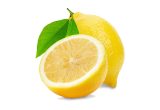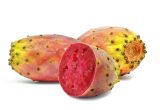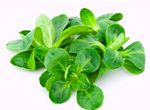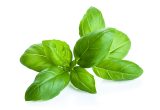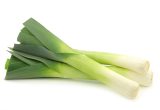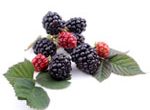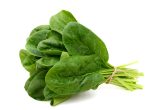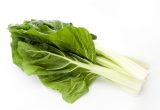Onion (red)

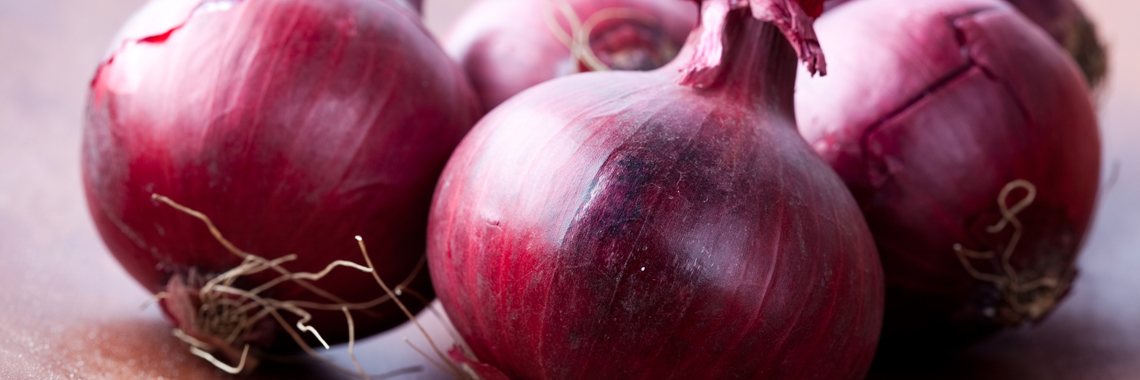
Description
- Onion belongs to the Alliaceae family, genus Allium, species cepa (Birlouez, 2016).
- It is a biennial plant native to Central Asia.
- Red onions are harvested in summer when the stems are completely dried out and flattened to the ground (Olsson, 2010).
- There are many varieties of red onion, such as the Red Baron, the Brunswick red onion or the Roscoff pink onion. The latter benefits from the protected designation of origin (PDO) because it is produced in the north of Finistère (Marchenay, 2005), guaranteeing a certain level of quality (Minker, 2012).
- It can be eaten cooked or raw, in salads.
PHYSICAL AND ORGANOLEPTIC CHARACTERISTICS
- The red onion consists of a stem, root, bulb and skin (Green, 1991).
- The shape of the bulb of the red onion is round and slightly flattened, and the colour of its skin is red (Abbey, 2005).
- Four polyphenols of the anthocyanin family have been quantified in red onion, giving it its red colour (Pérez-Gregorio, 2010).
- Red onion provides a sweet and mild flavour due to its higher carbohydrate content than other types of onions (Gennaro, 2002; Jeong, 2009).
COMPOSITION CHARACTERISTICS (excluding macronutrients, vitamins and minerals)
- According to a study on several onion cultivars, red onion has better oxidative capacity than yellow onion due to its high polyphenol content (Mlcek, 2015), especially in quercetin (Pérez-Gregorio, 2010). These phenolic compounds provide a protective role against cancers and chronic diseases (Jin-Seong, 2009).
RAW
The following values are approximate and depend on variety, season, ripeness, cultivation conditions, etc.
Raw red onions are low in energy*, providing an average of 36.30 calories (kcal) per 100 g, i.e. 153 kJ. The size of the onion varies according to the cultivar, but on average it is considered that a large onion weighs about 100 g.
COMPOSITION TABLES
For each nutrient, the tables provide information on the content, minimum and maximum values, as well as the percentage of Dietary Reference Values (DRVs) for 100 g of raw red onion.
*Regulation (EC) No 1924/2006 of the European Parliament and of the Council of 20 December 2006 on nutrition and health claims made on foods.
MACRONUTRIENTS
| Constituent (g) | Average content |
Min-Max per 100g |
DRV% |
|---|---|---|---|
| Water | 90,30 | - | - |
| Fibers | 2,50 | - | - |
| Carbohydrates | 5,63 | - | 2,17 |
| Sugars | 5,20 | - | 5,78 |
| Lipids | 0,40 | - | 0,57 |
| Saturated fat | 0,14 | - | 0,70 |
| Protein | 1,31 | 1,30 - NC | 2,62 |
| Constituent (g) | Amount | Min-Max | DRV% |
|---|---|---|---|
| Water | Ciqual 2020 (valeur issue des analyses Ciqual-Aprifel 2018) | - | - |
| Fibers | Ciqual 2020 (valeur issue des analyses Ciqual-Aprifel 2018) | - | - |
| Carbohydrates | Ciqual 2020 | - | Règlement (UE) N°1169/2011 du parlement Européen et du conseil du 25 octobre 2011 |
| Sugars | Ciqual 2020 (valeur issue des analyses Ciqual-Aprifel 2018) | - | Règlement (UE) N°1169/2011 du parlement Européen et du conseil du 25 octobre 2011 |
| Lipids | Ciqual 2020 (valeur issue des analyses Ciqual-Aprifel 2018) | - | Règlement (UE) N°1169/2011 du parlement Européen et du conseil du 25 octobre 2011 |
| Saturated fat | Ciqual 2020 (valeur issue des analyses Ciqual-Aprifel 2018) | - | Règlement (UE) N°1169/2011 du parlement Européen et du conseil du 25 octobre 2011 |
| Protein | Ciqual 2020 (valeur issue des analyses Ciqual-Aprifel 2018) | - | Règlement (UE) N°1169/2011 du parlement Européen et du conseil du 25 octobre 2011 |
Zoom on carbohydrates
- Raw red onion provides a significant amount of carbohydrates (5.63 g per 100 g), higher than the average carbohydrate content in raw vegetables (4.45 g per 100 g).
Zoom on lipids
- Raw red onion is fat-free* as it contains less than 0.5 g per 100 g.
*Regulation (EC) No 1924/2006 of the European Parliament and of the Council of 20 December 2006 on nutrition and health claims made on foods.
Zoom on fibres
- Raw red onion provides a significant amount of fibre (2.50 g per 100 g).
- This amount is slightly higher than the average quantity of fibre found in raw vegetables (2.43 g per 100 g).
Zoom on proteins
- The amount of protein in raw red onion (1.31 g per 100 g) is lower than the average protein content in raw vegetables (1.87 g per 100 g).
MINERALS AND TRACE ELEMENTS
| Constituent | Average content |
Min-Max per 100g |
DRV% |
|---|---|---|---|
| Calcium (mg) | 22 | - | 2,75 |
| Chloride (mg) | 20,70 | - | 2,59 |
| Copper (mg) | 0,05 | - | 5 |
| Iron (mg) | 0,19 | - | 1,36 |
| Iodine (µg) | < 20 | - | - |
| Magnesium (mg) | 9 | - | 2,40 |
| Manganese (mg) | 0,12 | - | 6 |
| Phosphorus (mg) | 29 | - | 4,14 |
| Potassium (mg) | 190 | - | 9,50 |
| Selenium (µg) | < 20 | - | - |
| Sodium (mg) | < 5 | - | - |
| Zinc (mg) | 0,21 | - | 2,10 |
| Constituent | Amount | Min-Max | DRV% |
|---|---|---|---|
| Calcium (mg) | Ciqual 2020 (valeur issue des analyses Ciqual-Aprifel 2018) | - | Règlement (UE) N°1169/2011 du parlement Européen et du conseil du 25 octobre 2011 |
| Chloride (mg) | Ciqual 2020 (valeur issue des analyses Ciqual-Aprifel 2018) | - | Règlement (UE) N°1169/2011 du parlement Européen et du conseil du 25 octobre 2011 |
| Copper (mg) | Ciqual 2020 (valeur issue des analyses Ciqual-Aprifel 2018) | - | Règlement (UE) N°1169/2011 du parlement Européen et du conseil du 25 octobre 2011 |
| Iron (mg) | Ciqual 2020 (valeur issue des analyses Ciqual-Aprifel 2018) | - | Règlement (UE) N°1169/2011 du parlement Européen et du conseil du 25 octobre 2011 |
| Iodine (µg) | Ciqual 2020 (valeur issue des analyses Ciqual-Aprifel 2018) | - | Règlement (UE) N°1169/2011 du parlement Européen et du conseil du 25 octobre 2011 |
| Magnesium (mg) | Ciqual 2020 (valeur issue des analyses Ciqual-Aprifel 2018) | - | Règlement (UE) N°1169/2011 du parlement Européen et du conseil du 25 octobre 2011 |
| Manganese (mg) | Ciqual 2020 (valeur issue des analyses Ciqual-Aprifel 2018) | - | Règlement (UE) N°1169/2011 du parlement Européen et du conseil du 25 octobre 2011 |
| Phosphorus (mg) | Ciqual 2020 (valeur issue des analyses Ciqual-Aprifel 2018) | - | Règlement (UE) N°1169/2011 du parlement Européen et du conseil du 25 octobre 2011 |
| Potassium (mg) | Ciqual 2020 (valeur issue des analyses Ciqual-Aprifel 2018) | - | Règlement (UE) N°1169/2011 du parlement Européen et du conseil du 25 octobre 2011 |
| Selenium (µg) | Ciqual 2020 (valeur issue des analyses Ciqual-Aprifel 2018) | - | Règlement (UE) N°1169/2011 du parlement Européen et du conseil du 25 octobre 2011 |
| Sodium (mg) | Ciqual 2020 (valeur issue des analyses Ciqual-Aprifel 2018) | - | - |
| Zinc (mg) | Ciqual 2020 (valeur issue des analyses Ciqual-Aprifel 2018) | - | Règlement (UE) N°1169/2011 du parlement Européen et du conseil du 25 octobre 2011 |
Zoom on minerals and trace elements
- Raw red onion provides the equivalent of:
- 9.50% of DRVs for potassium, i.e. 190 mg per 100 g;
- 6% of DRVs for manganese, i.e. 0.12 mg per 100 g;
- 5% of DRVs for copper, i.e. 0.05 mg per 100 g.
- The other minerals and trace elements are present in quantities representing less than 5% of DRVs.
VITAMINS
| Constituent | Average content |
Min-Max per 100g |
DRV% |
|---|---|---|---|
| Provitamin A Beta-carotene (µg) | < 5 | - | - |
| Vitamin A equivalent (µg) | - | - | - |
| Vitamin B1 (mg) | 0,029 | - | 2,64 |
| Vitamin B2 (mg) | < 0,01 | - | - |
| Vitamin B3 (mg) | 0,18 | - | 1,13 |
| Vitamin B5 (mg) | 0,15 | - | 2,50 |
| Vitamin B6 (mg) | 0,049 | - | 3,50 |
| Vitamin B9 (µg) | 10,90 | - | 5,45 |
| Vitamin C (mg) | 4,09 | - | 5,11 |
| Vitamin E (mg) | 0,12 | - | 1 |
| Vitamin K1 (µg) | < 0,80 | - | - |
| Constituent | Amount | Min-Max | DRV% |
|---|---|---|---|
| Provitamin A Beta-carotene (µg) | Ciqual 2020 (valeur issue des analyses Ciqual-Aprifel 2018) | - | - |
| Vitamin A equivalent (µg) | Calcul à partir de la valeur Provitaine A Béta-carotène* | - | Règlement (UE) N°1169/2011 du parlement Européen et du conseil du 25 octobre 2011 |
| Vitamin B1 (mg) | Ciqual 2020 (valeur issue des analyses Ciqual-Aprifel 2018) | - | Règlement (UE) N°1169/2011 du parlement Européen et du conseil du 25 octobre 2011 |
| Vitamin B2 (mg) | Ciqual 2020 (valeur issue des analyses Ciqual-Aprifel 2018) | - | Règlement (UE) N°1169/2011 du parlement Européen et du conseil du 25 octobre 2011 |
| Vitamin B3 (mg) | Ciqual 2020 (valeur issue des analyses Ciqual-Aprifel 2018) | - | Règlement (UE) N°1169/2011 du parlement Européen et du conseil du 25 octobre 2011 |
| Vitamin B5 (mg) | Ciqual 2020 (valeur issue des analyses Ciqual-Aprifel 2018) | - | Règlement (UE) N°1169/2011 du parlement Européen et du conseil du 25 octobre 2011 |
| Vitamin B6 (mg) | Ciqual 2020 (valeur issue des analyses Ciqual-Aprifel 2018) | - | Règlement (UE) N°1169/2011 du parlement Européen et du conseil du 25 octobre 2011 |
| Vitamin B9 (µg) | Ciqual 2020 (valeur issue des analyses Ciqual-Aprifel 2018) | - | Règlement (UE) N°1169/2011 du parlement Européen et du conseil du 25 octobre 2011 |
| Vitamin C (mg) | Ciqual 2020 (valeur issue des analyses Ciqual-Aprifel 2018) | - | Règlement (UE) N°1169/2011 du parlement Européen et du conseil du 25 octobre 2011 |
| Vitamin E (mg) | Ciqual 2020 | - | Règlement (UE) N°1169/2011 du parlement Européen et du conseil du 25 octobre 2011 |
| Vitamin K1 (µg) | Ciqual 2020 (valeur issue des analyses Ciqual-Aprifel 2018) | - | Règlement (UE) N°1169/2011 du parlement Européen et du conseil du 25 octobre 2011 |
Zoom on vitamins
- Raw red onion provides the equivalent of:
- 5.45% of DRVs for vitamin B9, i.e. 10.90 µg per 100 g;
- 5.11% of DRVs for vitamin C, i.e. 4.09 mg per 100 g.
- The amount of other vitamins represents less than 4% of DRVs.
POLYPHENOLS
| Constituent (mg) | Average content |
Min-Max per 100mg |
|---|---|---|
| Flavonoids (mg) | 135,71 | 67,20 - 403,48 |
| of which Flavonols (mg) | 128,51 | 58,20 - 394,48 |
| of which Anthocyanins (mg) | 9 | 9 - 9 |
| Phenolic Acids (mg) | 2 | 2 - 2 |
| of which Hydroxybenzoic acids (mg) | 2 | 2 - 2 |
| Total polyphenols | 139,51 | 69,20 - 405,48 |
| Constituent (mg) | Amount | Min-Max |
|---|---|---|
| Flavonoids | Phénol-Explorer version 3.6 Méthode utilisée : Chromatographie | - |
| of which Flavonols | Phénol-Explorer version 3.6 Méthode utilisée : Chromatographie | - |
| of which Anthocyanins | Phénol-Explorer version 3.6 Méthode utilisée : Chromatographie | - |
| Phenolic Acids | Phénol-Explorer version 3.6 Méthode utilisée : Chromatographie | - |
| of which Hydroxybenzoic acids | Phénol-Explorer version 3.6 Méthode utilisée : Chromatographie | - |
| Total polyphenols | Phénol-Explorer version 3.6 Méthode utilisée : Chromatographie | - |
Zoom on polyphenols
- Polyphenols are substances with an antioxidant effect.
- Flavonols, being part of the flavonoids, are predominantly present in raw red onion composites, representing 92.01% of the total polyphenols identified.
- Next come anthocyanins, which are also flavonoids, representing 6.54% of total polyphenols.
- Hydroxybenzoic acids represent only 1.45% of the total polyphenols.
SAUTÉED
The following values are approximate and depend on variety, season, ripeness, cultivation conditions, etc.
Sautéed red onion provides an average of 42.40 kcal per 100 g, i.e. 179 kJ. The size of the onion varies according to the cultivar, but on average a large onion is considered to weigh about 100 g.
COMPOSITION TABLES
For each nutrient, the tables provide information on the content, the minimum and maximum values and the percentage of the Dietary Reference Values (DRVs) for 100 g net of cooked red onion (sautéed/fried, without fat).
MACRONUTRIENTS
| Constituent (g) | Average content |
Min-Max per 100g |
DRV% |
|---|---|---|---|
| Water | 87,9 | - | - |
| Fibers | 2,10 | - | - |
| Carbohydrates | 7,55 | - | 2,90 |
| Sugars | 6,70 | - | 7,44 |
| Lipids | < 0,30 | - | - |
| Saturated fat | < 0,01 | - | - |
| Protein | 1,69 | NC - 1,7 | 3,38 |
| Constituent (g) | Amount | Min-Max | DRV% |
|---|---|---|---|
| Water | Ciqual 2020 (valeur issue des analyses Ciqual-Aprifel 2018) | - | - |
| Fibers | Ciqual 2020 (valeur issue des analyses Ciqual-Aprifel 2018) | - | Règlement (UE) N°1169/2011 du parlement Européen et du conseil du 25 octobre 2011 |
| Carbohydrates | Ciqual 2020 | - | Règlement (UE) N°1169/2011 du parlement Européen et du conseil du 25 octobre 2011 |
| Sugars | Ciqual 2020 (valeur issue des analyses Ciqual-Aprifel 2018) | - | Règlement (UE) N°1169/2011 du parlement Européen et du conseil du 25 octobre 2011 |
| Lipids | Ciqual 2020 (valeur issue des analyses Ciqual-Aprifel 2018) | - | Règlement (UE) N°1169/2011 du parlement Européen et du conseil du 25 octobre 2011 |
| Saturated fat | Ciqual 2020 (valeur issue des analyses Ciqual-Aprifel 2018) | - | Règlement (UE) N°1169/2011 du parlement Européen et du conseil du 25 octobre 2011 |
| Protein | Ciqual 2020 (valeur issue des analyses Ciqual-Aprifel 2018) | - | Règlement (UE) N°1169/2011 du parlement Européen et du conseil du 25 octobre 2011 |
Zoom on carbohydrates
- Sautéed red onion provides a higher amount of carbohydrates (7.55 g per 100 g) than the average quantity found in cooked vegetables (4.85 g per 100 g).
Zoom on lipids
- Sautéed red onion is fat-free* as it contains less than 0.5 g per 100 g.
*Regulation (EC) No 1924/2006 of the European Parliament and of the Council of 20 December 2006 on nutrition and health claims made on foods.
Zoom on fibres
- Sautéed red onion provides a significant amount of fibre (2.10 g per 100 g).
- This amount is below the average quantity found in cooked vegetables (2.89 g per 100 g).
Zoom on proteins
- The amount of protein in sautéed red onion (1.69 g per 100 g) is lower than the average quantity found in cooked vegetables (2 g per 100 g)
MINERALS AND TRACE ELEMENTS
| Constituent | Average content |
Min-Max per 100g |
DRV% |
|---|---|---|---|
| Calcium (mg) | 26 | - | 3,25 |
| Chloride (mg) | 22,09 | - | 2,76 |
| Copper (mg) | 0,07 | - | 7 |
| Iron (mg) | 0,26 | - | 1,86 |
| Iodine (µg) | < 20 | - | - |
| Magnesium (mg) | 10 | - | 2,67 |
| Manganese (mg) | 0,15 | - | 7,50 |
| Phosphorus (mg) | 33 | - | 4,71 |
| Potassium (mg) | 220 | - | 11 |
| Selenium (µg) | < 20 | - | - |
| Sodium (mg) | < 5 | - | - |
| Zinc (mg) | 0,26 | - | 2,60 |
| Constituent | Amount | Min-Max | DRV% |
|---|---|---|---|
| Calcium (mg) | Ciqual 2020 (valeur issue des analyses Ciqual-Aprifel 2018) | - | Règlement (UE) N°1169/2011 du parlement Européen et du conseil du 25 octobre 2011 |
| Chloride (mg) | Ciqual 2020 (valeur issue des analyses Ciqual-Aprifel 2018) | - | Règlement (UE) N°1169/2011 du parlement Européen et du conseil du 25 octobre 2011 |
| Copper (mg) | Ciqual 2020 (valeur issue des analyses Ciqual-Aprifel 2018) | - | Règlement (UE) N°1169/2011 du parlement Européen et du conseil du 25 octobre 2011 |
| Iron (mg) | Ciqual 2020 (valeur issue des analyses Ciqual-Aprifel 2018) | - | Règlement (UE) N°1169/2011 du parlement Européen et du conseil du 25 octobre 2011 |
| Iodine (µg) | Ciqual 2020 (valeur issue des analyses Ciqual-Aprifel 2018) | - | Règlement (UE) N°1169/2011 du parlement Européen et du conseil du 25 octobre 2011 |
| Magnesium (mg) | Ciqual 2020 (valeur issue des analyses Ciqual-Aprifel 2018) | - | Règlement (UE) N°1169/2011 du parlement Européen et du conseil du 25 octobre 2011 |
| Manganese (mg) | Ciqual 2020 (valeur issue des analyses Ciqual-Aprifel 2018) | - | Règlement (UE) N°1169/2011 du parlement Européen et du conseil du 25 octobre 2011 |
| Phosphorus (mg) | Ciqual 2020 (valeur issue des analyses Ciqual-Aprifel 2018) | - | Règlement (UE) N°1169/2011 du parlement Européen et du conseil du 25 octobre 2011 |
| Potassium (mg) | Ciqual 2020 (valeur issue des analyses Ciqual-Aprifel 2018) | - | Règlement (UE) N°1169/2011 du parlement Européen et du conseil du 25 octobre 2011 |
| Selenium (µg) | Ciqual 2020 (valeur issue des analyses Ciqual-Aprifel 2018) | - | Règlement (UE) N°1169/2011 du parlement Européen et du conseil du 25 octobre 2011 |
| Sodium (mg) | Ciqual 2020 (valeur issue des analyses Ciqual-Aprifel 2018) | - | - |
| Zinc (mg) | Ciqual 2020 (valeur issue des analyses Ciqual-Aprifel 2018) | - | Règlement (UE) N°1169/2011 du parlement Européen et du conseil du 25 octobre 2011 |
Zoom on minerals and trace elements
- Sautéed red onion contains a significant amount of potassium equivalent to 11% of DRVs, i.e. 220 mg per 100 g.
- It also provides the equivalent of:
- 7.50% of DRVs for manganese, i.e. 0.15 mg per 100 g;
- 7% of DRVs for copper, i.e. 0.07 mg per 100 g.
- The other minerals and trace elements are present in quantities representing less than 5% of DRVs.
VITAMINS
| Constituent | Average content |
Min-Max per 100g |
DRV% |
|---|---|---|---|
| Provitamin A Beta-carotene (µg) | < 5 | - | - |
| Vitamin A equivalent (µg) | - | - | - |
| Vitamin B1 (mg) | 0,031 | - | 2,82 |
| Vitamin B2 (mg) | < 0,01 | - | - |
| Vitamin B3 (mg) | 0,15 | - | 0,94 |
| Vitamin B5 (mg) | 0,19 | - | 3,17 |
| Vitamin B6 (mg) | 0,062 | - | 4,43 |
| Vitamin B9 (µg) | 33,30 | - | 16,65 |
| Vitamin C (mg) | 5,68 | - | 7,10 |
| Vitamin E (mg) | < 0,50 | - | - |
| Vitamin K1 (µg) | < 0,80 | - | - |
| Constituent | Amount | Min-Max | DRV% |
|---|---|---|---|
| Provitamin A Beta-carotene (µg) | Ciqual 2020 (valeur issue des analyses Ciqual-Aprifel 2018) | - | - |
| Vitamin A equivalent (µg) | - | - | Règlement (UE) N°1169/2011 du parlement Européen et du conseil du 25 octobre 2011 |
| Vitamin B1 (mg) | Ciqual 2020 (valeur issue des analyses Ciqual-Aprifel 2018) | - | Règlement (UE) N°1169/2011 du parlement Européen et du conseil du 25 octobre 2011 |
| Vitamin B2 (mg) | Ciqual 2020 (valeur issue des analyses Ciqual-Aprifel 2018) | - | Règlement (UE) N°1169/2011 du parlement Européen et du conseil du 25 octobre 2011 |
| Vitamin B3 (mg) | Ciqual 2020 (valeur issue des analyses Ciqual-Aprifel 2018) | - | Règlement (UE) N°1169/2011 du parlement Européen et du conseil du 25 octobre 2011 |
| Vitamin B5 (mg) | Ciqual 2020 (valeur issue des analyses Ciqual-Aprifel 2018) | - | Règlement (UE) N°1169/2011 du parlement Européen et du conseil du 25 octobre 2011 |
| Vitamin B6 (mg) | Ciqual 2020 (valeur issue des analyses Ciqual-Aprifel 2018) | - | Règlement (UE) N°1169/2011 du parlement Européen et du conseil du 25 octobre 2011 |
| Vitamin B9 (µg) | Ciqual 2020 (valeur issue des analyses Ciqual-Aprifel 2018) | - | Règlement (UE) N°1169/2011 du parlement Européen et du conseil du 25 octobre 2011 |
| Vitamin C (mg) | Ciqual 2020 (valeur issue des analyses Ciqual-Aprifel 2018) | - | Règlement (UE) N°1169/2011 du parlement Européen et du conseil du 25 octobre 2011 |
| Vitamin E (mg) | Ciqual 2020 | - | Règlement (UE) N°1169/2011 du parlement Européen et du conseil du 25 octobre 2011 |
| Vitamin K1 (µg) | Ciqual 2020 (valeur issue des analyses Ciqual-Aprifel 2018) | - | Règlement (UE) N°1169/2011 du parlement Européen et du conseil du 25 octobre 2011 |
Zoom on vitamins
- When sautéed, red onion is a source of vitamin B9 as it provides the equivalent of 16.65% of DRVs, i.e. 33.30 µg per 100 g.
- It also provides the equivalent of:
- 7.10% of DRVs for vitamin C, i.e. 5.68 mg per 100 g;
- 4.43% of DRVs for vitamin B6, i.e. 0.062 mg per 100 g.
- The amount of other vitamins represents less than 4% of DRVs.
POLYPHENOLS
Nutrition and health claims
According to the definitions of nutrition claims as set out in Regulation (EC) No 1924/2006 on nutrition and health claims, and in view of the composition of raw red onion, the following claim may be used:
NUTRITION CLAIMS OF RAW RED ONION
- Low in energy (100 g of raw red onion provide less than 40 kcal)
- Fat-free (100 g of raw red onion contain less than 0.5 g of fat)
Nutrition and health claims
According to the definitions of nutrition claims as set out in Regulation (EC) No 1924/2006 on nutrition and health claims, and in view of the composition of sautéed red onion, the following claims may be used:
NUTRITION CLAIMS OF SAUTEED RED ONION
- Source of vitamin B9 (100 g of sautéed red onion provide more than 15% of DRVs)
- Fat-free (100 g of sautéed red onion contain less than 0.5 g of fat)
HEALTH CLAIMS (for a consumption of 100 g of sautéed red onion)
Folates or vitamin B9
- Folates contribute to:
- maternal tissue growth during pregnancy,
- normal amino acid synthesis,
- normal blood formation,
- normal homocysteine metabolism,
- normal psychological function,
- normal function of the immune system,
- reduction of tiredness and fatigue.
- Folates have a role in the process of cell division.
References
- Abbey L, Kanto RAL, Danquah O-A, Olympio NS. Characteristics and storage performance of eight onion cultivars. Ghana Journal of Science. 2005;40(1)
- Agence nationale de sécurité sanitaire de l’alimentation, de l’environnement et du travail. Table de composition nutritionnelle des aliments Ciqual 2020. Consultée le 25/09/2020 depuis le site internet Ciqual https://ciqual.anses.fr/
- Birlouez E. Garlic, onion, and other Alliaceae: Historical and cultural approach. Phytothérapie. 2016;14:141-8.
- Gennaro L, Leonardi C, Esposito F, Salucci M, Maiani G, Quaglia G, Fogliano V. Flavonoid and Carbohydrate Contents in Tropea Red Onions: Effects of Homelike Peeling and Storage. J Agric Food Chem. 2002;50(7):1904-10.
- Green GR, Hodges JL. Method of peeling onions by scalding and cutting. US Patent. 1991.
- Jeong C-H, Heo HJ, Choi SG, Shim K-H. Antioxidant and Anticancer Properties of Methanolic Extracts from Different Parts of White, Yellow, and Red Onion. Science et biotechnologie alimentaires. 2009;18(1):108–12.
- Jin-Seong M, Hee-Dae K, In-Jong Ha, Sun-Young L, Jong L, Sang-Dae L. Chemical Component of Red Onion (Allium cepa L.) according to Cultivars and Growing Areas. Horticultural Science & Technology. 2010;28(6):921-7.
- Marchenay P, Bérard L. Variétés, savoir-faire, usages alimentaires : les cultures légumières locales dans L’inventaire du patrimoine culinaire de la France. Les légumes : un patrimoine à transmettre et à valoriser. 2005:107-36.
- Minker C (2012). Ail et autres alliacés : un concentré de bienfaits pour votre santé, votre beauté et votre jardin. Paris : Eyrolles, 158 p.
- Mlcek J, Valsikova M, DruzbikovaH, Ryant P, JurikovaT, Sochor J, Borkovcova M. The antioxidant capacity and macroelement content of several onion cultivars. Turk J Agric For. 2015;39:999-1004.
- Neveu V, Perez-Jiménez J, Vos F, Crespy V, du Chaffaut L, Mennen L, Knox C, Eisner R, Cruz J, Wishart D, Scalbert A. (2010) Phenol-Explorer: an online comprehensive database on polyphenol contents in foods. Database, doi: 10.1093/database/bap024. Full text (free access)
- Olsson M.E, Gustavsson K-E, Vagen IM. Quercetin and Isorhamnetin in Sweet and Red Cultivars of Onion (Allium cepa L.) at Harvest, after Field Curing, Heat Treatment, and Storage. J. Agric. Food Chem. 2010;58(4)2323-30.
- Pérez-Gregorio RM, García-Falcón MC, Simal-Gándara J, Rodrigues AS, PF Almeidac A. Identification and quantification of flavonoids in traditional cultivars of red and white onions at harvest. Journal of Food Composition and Analysis. 2010;23(6):592-8.
- Règlement (CE) N° 1924/2006 du Parlement européen et du Conseil du 20 décembre 2006 concernant les allégations nutritionnelles et de santé portant sur les denrées alimentaires.
- Règlement (UE) N°432/2012 de la Commission du 16 mai 2012 établissant une liste des allégations de santé autorisées portant sur les denrées alimentaires, autres que celles faisant référence à la réduction du risque de maladie ainsi qu’au développement et à la santé infantiles.
- Règlement (UE) n°1169/2011 du Parlement européen et du Conseil du 25 octobre 2011 concernant l’information des consommateurs sur les denrées alimentaires, modifiant les règlements (CE) n°1924/2006 et (CE) n°1925/2006 du Parlement européen et de Conseil et abrogeant la directive 87/250/CEE de la Commission, la directive 90/496/CEE du Conseil, la directive 1999/10/CE de la Commission, la directive 200/13/CE du Parlement européen et du Conseil, les directives 2002/67/CE et 2008/5/CE de la Commission et le règlement (CE) n°608/2004 de la Commission.





